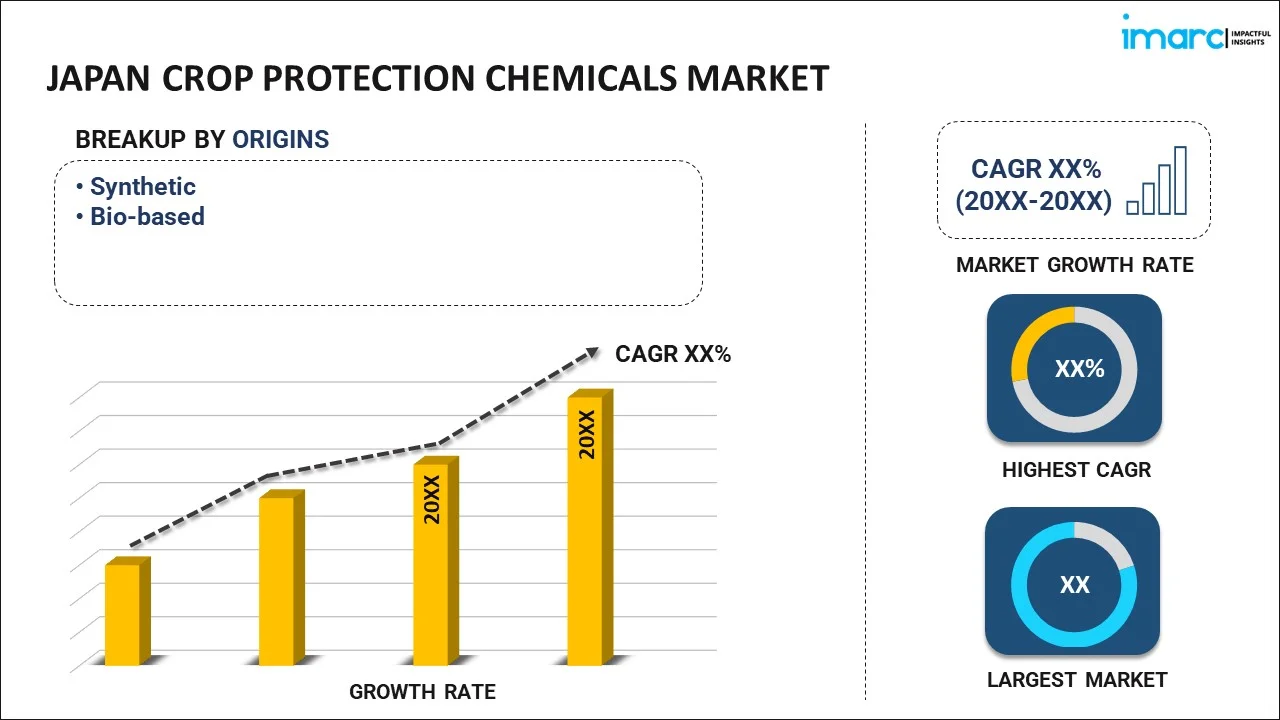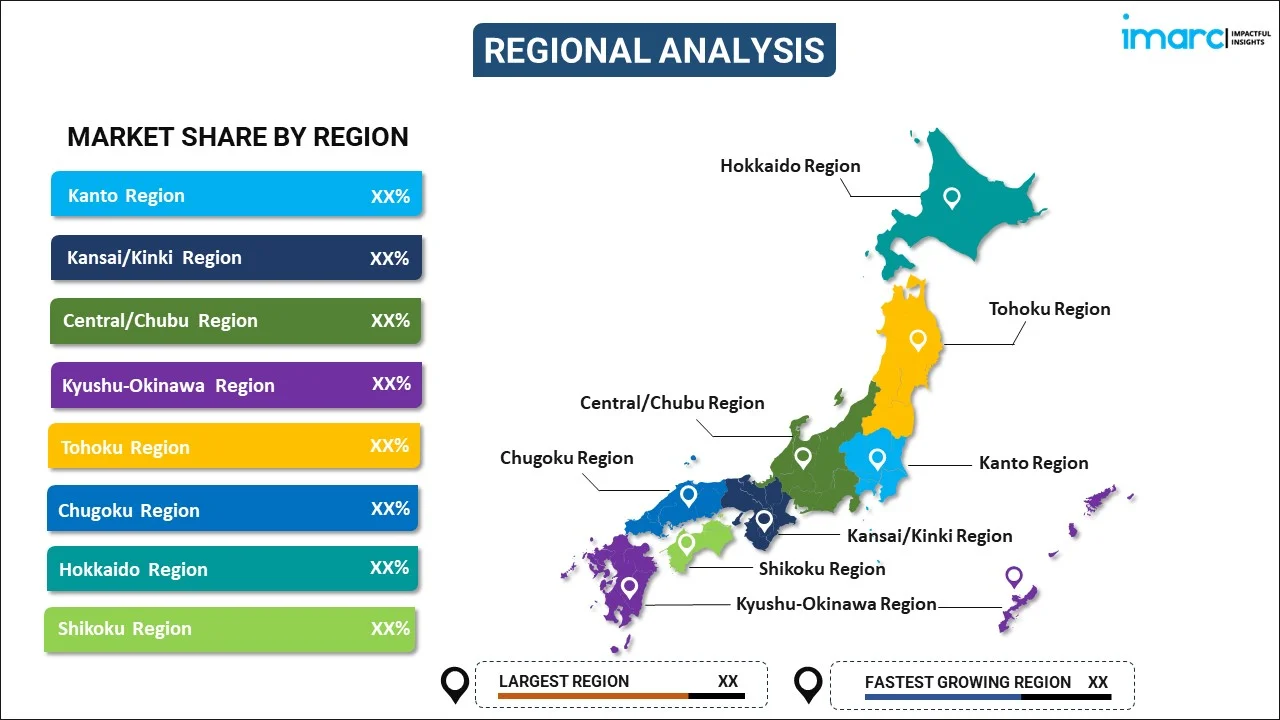
Japan Crop Protection Chemicals Market Report by Origin (Synthetic, Bio-based), Type (Herbicide, Fungicide, Insecticide, and Others), Application (Grains and Cereals, Pulses and Oilseeds, Fruits and Vegetables, Commercial Crops, and Others), and Region 2025-2033
Market Overview:
Japan crop protection chemicals market size reached USD 1.4 Billion in 2024. Looking forward, IMARC Group expects the market to reach USD 2.3 Billion by 2033, exhibiting a growth rate (CAGR) of 4.6% during 2025-2033. The market is being driven by significant factors, such as changing consumer preferences, technological advancements, government backing and regulatory measures, and increased pest pressure caused by climate change.
|
Report Attribute
|
Key Statistics
|
|---|---|
|
Base Year
|
2024 |
|
Forecast Years
|
2025-2033
|
|
Historical Years
|
2019-2024
|
| Market Size in 2024 | USD 1.4 Billion |
| Market Forecast in 2033 | USD 2.3 Billion |
| Market Growth Rate (2025-2033) | 4.6% |
Crop protection chemicals, also known as agricultural pesticides, are chemical substances utilized in agriculture to safeguard crops from pests, diseases, and weeds. These chemicals play a vital role in ensuring the effectiveness and profitability of agricultural practices. Crop protection chemicals encompass a broad spectrum of products, which include insecticides, herbicides, fungicides, and rodenticides, each tailored to address specific pests or plant ailments. Insecticides serve the purpose of managing and eradicating insects that pose a threat to crops by consuming leaves, stems, or fruits. Herbicides are employed to suppress or exterminate unwanted plants, commonly referred to as weeds, which compete with crops for essential resources such as water, sunlight, and nutrients. Fungicides, conversely, are designed to prevent and control fungal infections that can significantly compromise crop yield and quality. Additionally, rodenticides are employed to regulate rodent populations that have the potential to inflict extensive harm to crops during their feeding activities. The efficacy, safety, and environmental sustainability of crop protection chemicals are ensured through rigorous testing and assessment procedures. These chemicals are typically administered using a variety of methods, including spraying, seed treatment, and soil application, depending on the specific crop and the particular pest or disease targeted.
Japan Crop Protection Chemicals Market Trends:
The Japan crop protection chemicals market is a dynamic and vital component of the country's agricultural sector. This market plays a critical role in safeguarding Japan's agricultural productivity and ensuring food security by protecting crops from pests, diseases, and weeds. With a strong emphasis on technological advancements and environmental sustainability, Japan has witnessed a consistent evolution in its crop protection practices. The market in Japan encompasses a wide range of products, including insecticides, herbicides, fungicides, and rodenticides, tailored to address the unique challenges faced by Japanese farmers. Moreover, Japan's commitment to stringent regulatory standards and safety measures ensures that crop protection chemicals used in the country meet high-quality and safety criteria. This, in turn, is bolstering the regional market in the coming years.
Japan Crop Protection Chemicals Market Segmentation:
IMARC Group provides an analysis of the key trends in each segment of the market, along with forecasts at the country level for 2025-2033. Our report has categorized the market based on origin, type, and application.
Origin Insights:

- Synthetic
- Bio-based
The report has provided a detailed breakup and analysis of the market based on the origin. This includes synthetic and bio-based.
Type Insights:
- Herbicide
- Fungicide
- Insecticide
- Others
A detailed breakup and analysis of the market based on the type have also been provided in the report. This includes herbicide, fungicide, insecticide, and others.
Application Insights:
- Grains and Cereals
- Pulses and Oilseeds
- Fruits and Vegetables
- Commercial Crops
- Others
The report has provided a detailed breakup and analysis of the market based on the application. This includes grains and cereals, pulses and oilseeds, fruits and vegetables, commercial crops, and others.
Regional Insights:

- Kanto Region
- Kansai/Kinki Region
- Central/ Chubu Region
- Kyushu-Okinawa Region
- Tohoku Region
- Chugoku Region
- Hokkaido Region
- Shikoku Region
The report has also provided a comprehensive analysis of all the major regional markets, which include Kanto Region, Kansai/Kinki Region, Central/ Chubu Region, Kyushu-Okinawa Region, Tohoku Region, Chugoku Region, Hokkaido Region, and Shikoku Region.
Competitive Landscape:
The market research report has also provided a comprehensive analysis of the competitive landscape. Competitive analysis such as market structure, key player positioning, top winning strategies, competitive dashboard, and company evaluation quadrant has been covered in the report. Also, detailed profiles of all major companies have been provided. Some of the key players include:
- BASF SE
- Bayer Holding Ltd.
- FMC Corporation
- Kumiai Chemical Industry Co. Ltd.
- Nissan Chemical Corporation
- Sumitomo Chemical Co. Ltd.
- Syngenta AG (Syngenta Group (Nl) B.V.)
(Please note that this is only a partial list of the key players, and the complete list is provided in the report.)
Japan Crop Protection Chemicals Market Report Coverage:
| Report Features | Details |
|---|---|
| Base Year of the Analysis | 2024 |
| Historical Period | 2019-2024 |
| Forecast Period | 2025-2033 |
| Units | Billion USD |
| Scope of the Report | Exploration of Historical and Forecast Trends, Industry Catalysts and Challenges, Segment-Wise Historical and Predictive Market Assessment:
|
| Origins Covered | Synthetic, Bio-based |
| Types Covered | Herbicide, Fungicide, Insecticide, Others |
| Applications Covered | Grains and Cereals, Pulses and Oilseeds, Fruits and Vegetables, Commercial Crops, Others |
| Regions Covered | Kanto Region, Kansai/Kinki Region, Central/ Chubu Region, Kyushu-Okinawa Region, Tohoku Region, Chugoku Region, Hokkaido Region, Shikoku Region |
| Companies Covered | BASF SE, Bayer Holding Ltd., FMC Corporation, Kumiai Chemical Industry Co. Ltd., Nissan Chemical Corporation, Sumitomo Chemical Co. Ltd., Syngenta AG (Syngenta Group (Nl) B.V.), etc |
| Customization Scope | 10% Free Customization |
| Post-Sale Analyst Support | 10-12 Weeks |
| Delivery Format | PDF and Excel through Email (We can also provide the editable version of the report in PPT/Word format on special request) |
Key Questions Answered in This Report:
- How has the Japan crop protection chemicals market performed so far and how will it perform in the coming years?
- What has been the impact of COVID-19 on the Japan crop protection chemicals market?
- What is the breakup of the Japan crop protection chemicals market on the basis of origin?
- What is the breakup of the Japan crop protection chemicals market on the basis of type?
- What is the breakup of the Japan crop protection chemicals market on the basis of application?
- What are the various stages in the value chain of the Japan crop protection chemicals market?
- What are the key driving factors and challenges in the Japan crop protection chemicals?
- What is the structure of the Japan crop protection chemicals market and who are the key players?
- What is the degree of competition in the Japan crop protection chemicals market?
Key Benefits for Stakeholders:
- IMARC’s industry report offers a comprehensive quantitative analysis of various market segments, historical and current market trends, market forecasts, and dynamics of the Japan crop protection chemicals market from 2019-2033.
- The research report provides the latest information on the market drivers, challenges, and opportunities in the Japan crop protection chemicals market.
- Porter's five forces analysis assist stakeholders in assessing the impact of new entrants, competitive rivalry, supplier power, buyer power, and the threat of substitution. It helps stakeholders to analyze the level of competition within the Japan crop protection chemicals industry and its attractiveness.
- Competitive landscape allows stakeholders to understand their competitive environment and provides an insight into the current positions of key players in the market.
Need more help?
- Speak to our experienced analysts for insights on the current market scenarios.
- Include additional segments and countries to customize the report as per your requirement.
- Gain an unparalleled competitive advantage in your domain by understanding how to utilize the report and positively impacting your operations and revenue.
- For further assistance, please connect with our analysts.
 Request Customization
Request Customization
 Speak to an Analyst
Speak to an Analyst
 Request Brochure
Request Brochure
 Inquire Before Buying
Inquire Before Buying




.webp)




.webp)












